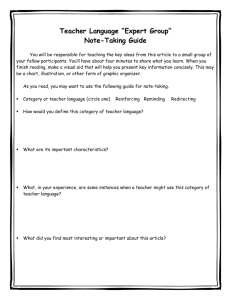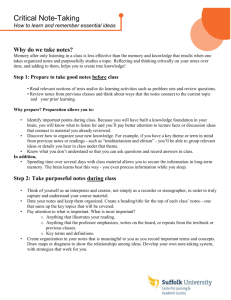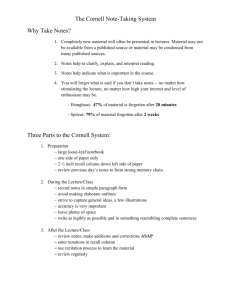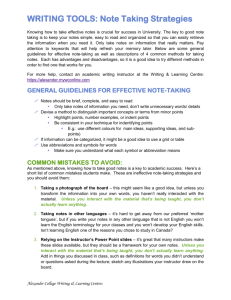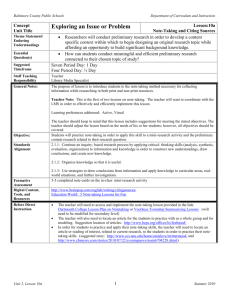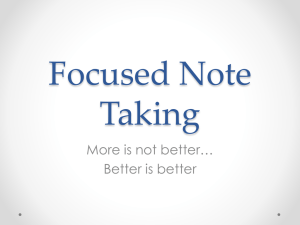Note-Taking Lesson Plan: Strategies & Cornell System
advertisement
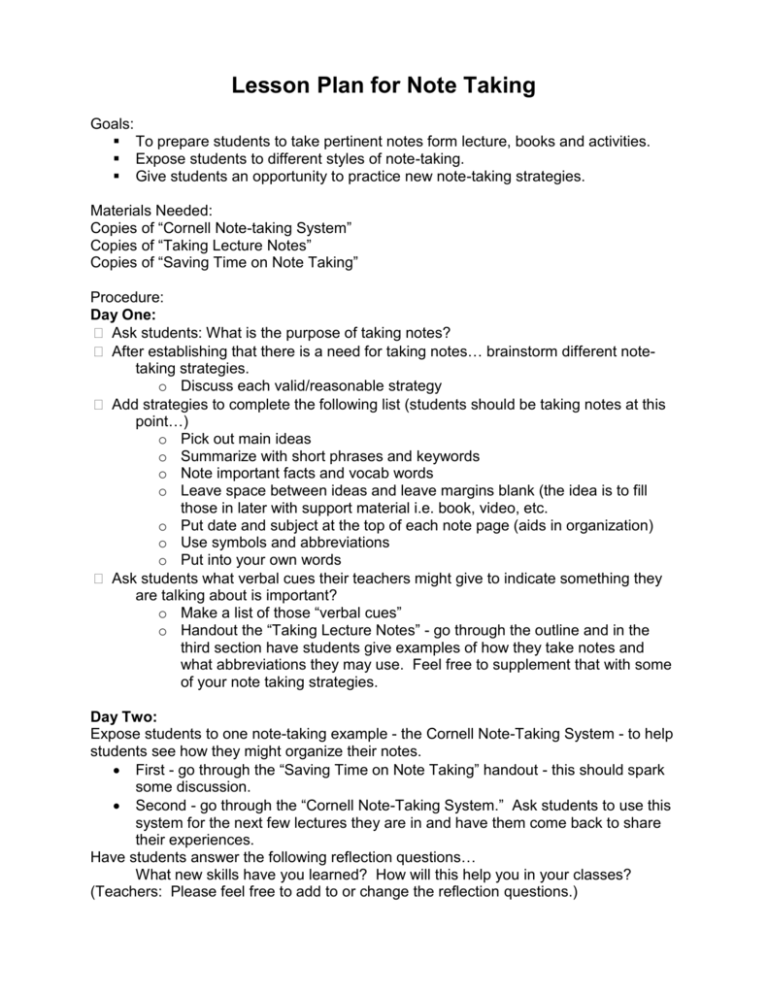
Lesson Plan for Note Taking Goals: To prepare students to take pertinent notes form lecture, books and activities. Expose students to different styles of note-taking. Give students an opportunity to practice new note-taking strategies. Materials Needed: Copies of “Cornell Note-taking System” Copies of “Taking Lecture Notes” Copies of “Saving Time on Note Taking” Procedure: Day One: Ask students: What is the purpose of taking notes? After establishing that there is a need for taking notes… brainstorm different notetaking strategies. o Discuss each valid/reasonable strategy Add strategies to complete the following list (students should be taking notes at this point…) o Pick out main ideas o Summarize with short phrases and keywords o Note important facts and vocab words o Leave space between ideas and leave margins blank (the idea is to fill those in later with support material i.e. book, video, etc. o Put date and subject at the top of each note page (aids in organization) o Use symbols and abbreviations o Put into your own words Ask students what verbal cues their teachers might give to indicate something they are talking about is important? o Make a list of those “verbal cues” o Handout the “Taking Lecture Notes” - go through the outline and in the third section have students give examples of how they take notes and what abbreviations they may use. Feel free to supplement that with some of your note taking strategies. Day Two: Expose students to one note-taking example - the Cornell Note-Taking System - to help students see how they might organize their notes. First - go through the “Saving Time on Note Taking” handout - this should spark some discussion. Second - go through the “Cornell Note-Taking System.” Ask students to use this system for the next few lectures they are in and have them come back to share their experiences. Have students answer the following reflection questions… What new skills have you learned? How will this help you in your classes? (Teachers: Please feel free to add to or change the reflection questions.) Cornell Note-Taking System 5 Step System - The 5 Rs 1. Record: During the lecture, record in the main column as many meaningful facts and ideas as you can. Write legibly. 2. Reduce: As soon after as possible, summarize these ideas and facts concisely in the Cue Column. Summarizing clarifies meanings and relationships, reinforces continuity, and strengthens memory. Also, it is a way of preparing for examinations gradually and well ahead of time. Questions: formulate questions based on the notes in the righthand column. Writing questions helps to clarify meanings, reveal relationships, establish continuity, and strengthen memory. Also, the writing of questions sets up a perfect stage for exam-studying later. Write those questions in the “Cue Column” 3. Recite: Cover the note-taking column with a sheet of paper. Then, looking at the questions or cue-words in the question and cue column only, say aloud, in your own words, the answers to the questions, facts, or ideas indicated by the cue-words. 4. Reflect: Reflect on the material by asking yourself questions, for example: “What’s the significance of these facts? What principle are they based on? How can I apply them? How do they fit in with what I already know? What’s beyond them? Then write your summary of that page’s notes in the “Summary” section at the bottom of your page. 5. Review: Spend at least ten minutes every week reviewing all your previous notes. If you do, you’ll retain a great deal for current use, as well as, for the exam. The Cornell System on paper would look like this… Cue Column 2.5” Note-Taking Area 11” 6” Summary 8.5” Students can generate their own note-taking paper at… http://incompetech.com/beta/linedGraphPaper/cornellLined.html TAKING LECTURE NOTES I. There are many reasons for taking lecture notes. A. Making yourself take notes forces you to listen carefully and test your understanding of the material. B. When you are reviewing, notes provide a gauge to what is important in the text. C. Personal notes are usually easier to remember than the text. D. The writing down of important points helps you to remember then even before you have studied the material formally. II. Instructors usually give clues to what is important to take down. Some of the more common clues are: A. Material written on the blackboard. B. Repetition C. Emphasis 1. Emphasis can be judged by tone of voice and gesture. 2. Emphasis can be judged by the amount of time the instructor spends on points and the number of examples he or she uses. D. Word signals (e.g. "There are two points of view on . . . " "The third reason is . . . " " In conclusion . . . ") E. Summaries given at the end of class. F. Reviews given at the beginning of class. III. Each student should develop his or her own method of taking notes, but most students find the following suggestions helpful: A. Make your notes brief. 1. Never use a sentence where you can use a phrase. Never use a phrase where you can use a word. 2. Use abbreviations and symbols, but be consistent. B. Put most notes in your own words. However, the following should be noted exactly: 1. Formulas 2. Definitions 3. Specific facts C. Use outline form and/or a numbering system. Indention helps you distinguish major from minor points. D. If you miss a statement, write key words, skip a few spaces, and get the information later. E. Don't try to use every space on the page. Leave room for coordinating your notes with the text after the lecture. (You may want to list key terms in the margin or make a summary of the contents of the page.) F. Date your notes. Perhaps number the pages. SAVING TIME ON NOTETAKING Here are some hints regarding taking notes on classroom lectures that can save time for almost any student. Some students say that they plan to rewrite or type their notes later. To do so is to use a double amount of time; once to take the original notes and a second to rewrite them. The advice is simple: DO IT RIGHT THE FIRST TIME! Second, there are some students who attempt to take notes in shorthand. Though shorthand is a valuable tool for a secretary, it is almost worthless for a student doing academic work. Here's why. Notes in shorthand cannot be studied in that form. They must first be transcribed. The act of transcribing notes takes an inordinate amount of time and energy but does not significantly contribute to their mastery. It is far better to have taken the notes originally in regular writing and then spend the time after that in direct study and recitation of the notes. Third, do not record the lesson on a cassette tape or any other tape. The lecture on tape precludes flexibility. This statement can be better understood when seen in the light of a person who has taken his/her notes in regular writing. Immediately after taking the notes this person can study them in five minutes before the next class as s/he walks toward the next building, as s/he drinks his/her coffee, or whatever. Furthermore, this student, in looking over his/her notes, may decide that the notes contain only four worthwhile ideas which s/he can highlight, relegating the rest of the lecture to obscurity. Whereas the lecture on tape has to be listened to in its entirety including the worthwhile points as well as the "garbage," handwritten notes may be studied selectively. A student who takes the easy way out - recording the lecture on tape as he or she sits back doing nothing - will box him or herself into inflexibility. NOTE MAKING Learning to make notes effectively will help you to improve your study and work habits and to remember important information. Often, students are deceived into thinking that because they understand everything that is said in class they will therefore remember it. This is dead wrong! Write it down. As you make notes, you will develop skill in selecting important material and in discarding unimportant material. The secret to developing this skill is practice. Check your results constantly. Strive to improve. Notes enable you to retain important facts and data and to develop an accurate means of arranging necessary information. Here are some hints on note making. 1. Don't write down everything that you read or hear. Be alert and attentive to the main points. Concentrate on the "meat" of the subject and forget the trimmings. 2. Notes should consist of key words or very short sentences. If a speaker gets sidetracked it is often possible to go back and add further information. 3. Take accurate notes. You should usually use your own words, but try not to change the meaning. If you quote directly from an author, quote correctly. 4. Think a minute about your material before you start making notes. Don't take notes just to be taking notes! Take notes that will be of real value to you when you look over them at a later date. 5. Have a uniform system of punctuation and abbreviation that will make sense to you. Use a skeleton outline and show importance by indenting. Leave lots of white space for later additions. 6. Omit descriptions and full explanations. Keep your notes short and to the point. Condense your material so you can grasp it rapidly. 7. Don't worry about missing a point. 8. Don't keep notes on oddly shaped pieces of paper. Keep notes in order and in one place. 9. Shortly after making your notes, go back and rework (not redo) your notes by adding extra points and spelling out unclear items. Remember, we forget rapidly. Budget time for this vital step just as you do for the class itself. 10. Review your notes regularly. This is the only way to achieve lasting memory. ©Academic Skills Center, Dartmouth College 2001
